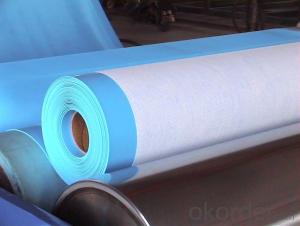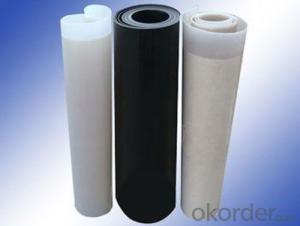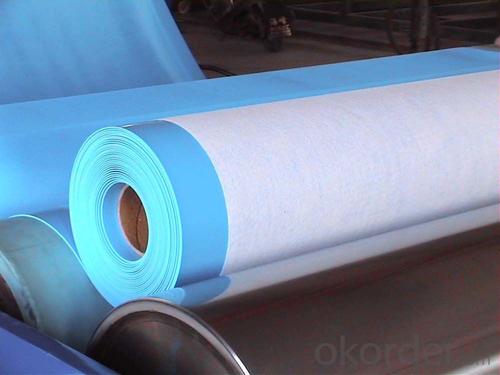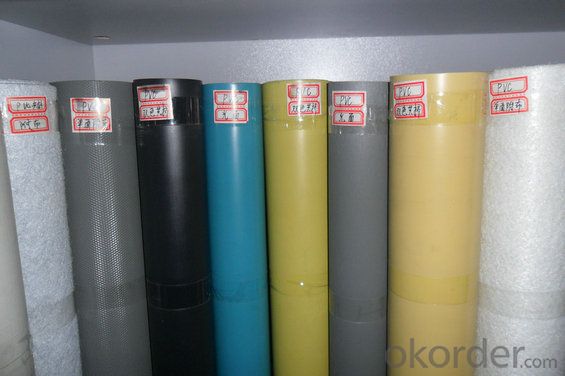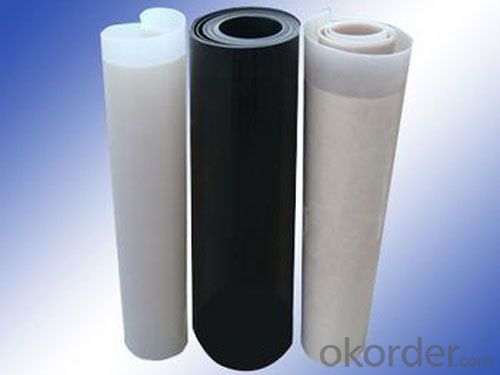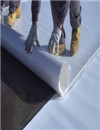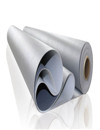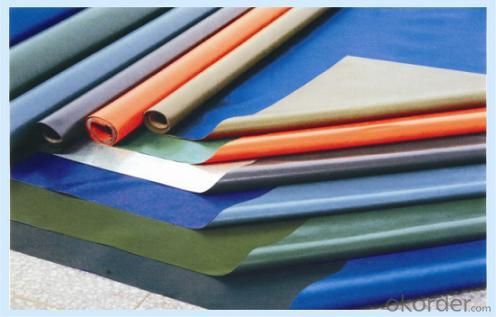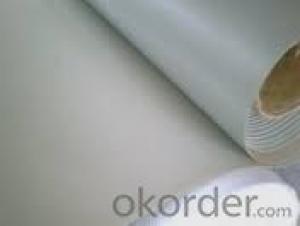Weldalbe EPDM rubber roofing waterproof membrane
- Loading Port:
- Qingdao
- Payment Terms:
- TT OR LC
- Min Order Qty:
- 20000 m²
- Supply Capability:
- 600000 m²/month
OKorder Service Pledge
OKorder Financial Service
You Might Also Like
Product Description of Weldalbe EPDM rubber roofing waterproof membrane:
EPDM waterproof membrane is of high elasticity among high polymer waterproof materials and becomes a world-popular waterproofing material. KEQIANG EPDM waterproof membrane is made from ternary ethylene-propylene rubber, which is designed for waterproofing of exposed and non-exposed applications. KEQIANG EPDM waterproof membrane production adopts the world-advanced equipment of cold feeding extrusion and continuous vulcanization technology.
Features of Weldalbe EPDM rubber roofing waterproof membrane:
·Excellent physical and mechanical performance
· High tearing resistance
· Good deformation adaptability
·High puncture resistance
·High aging resistance
·High UV resistance
Application of Weldalbe EPDM rubber roofing waterproof membrane:
l Roofs, Basement, Toilet
l Industrial and civil building waterproofing
l Geosynthetic liner for swimming pool, channels, irrigation system
l Especially suit for projects with high requirements in durability, anti-corrosion and deformation
Specification of Weldalbe EPDM rubber roofing waterproof membrane:
Tensile Strength N/CM | Normal temperature: 60 ; 60°C: 30 |
Breaking Elongation % | Normal temperature: 400 ; -20°C: 10 |
Tear Resistance N | 20 |
Impermeability, 30 min no leakage | 0.3Mpa |
Low Temperature Bending °C | -20 |
Heating Shrinking mm | Extension: 2 Shrink: 4 |
Heat Resistance (80°C×168h) | Tensile Strength % : 80 ; Keeping rate of adhesive breaking:70 |
Alkali resistance (10% ca (oh)2 solution,normal temperature ×168h)) | Tensile Strength % : 80 ; Keeping rate of adhesive breaking:80 |
Synthetic aging | Tensile Strength % : 80 ; Keeping rate of adhesive breaking:80 |
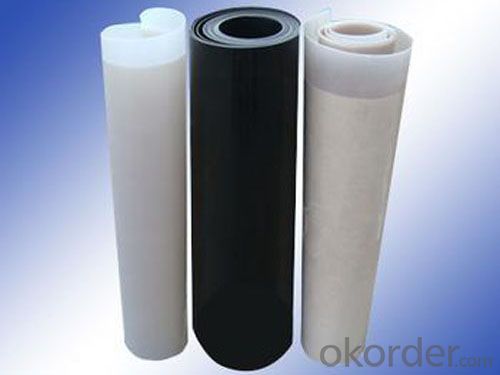
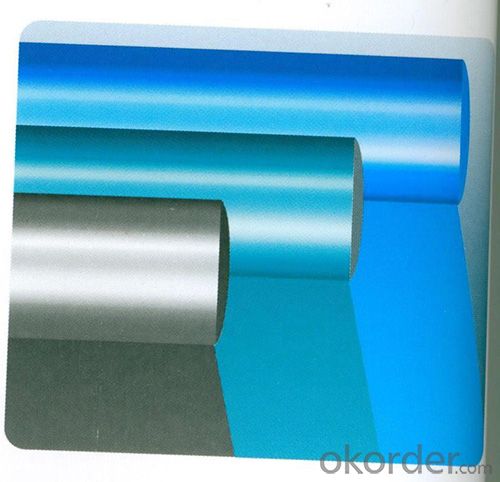
- Q: Is a waterproofing membrane resistant to algae or moss growth?
- A waterproofing membrane is usually resistant to the growth of algae or moss. Its purpose is to form a barrier against water infiltration, preventing moisture from seeping into the underlying structure. These membranes are typically composed of materials that are not favorable for the growth of algae or moss, such as synthetic polymers or rubberized compounds. Furthermore, they are often treated with additives that hinder the growth of organic matter, including algae or moss. Nevertheless, it is crucial to acknowledge that if the membrane is consistently exposed to moisture or damp conditions over time, it may become a breeding ground for algae or moss. Therefore, it is important to regularly maintain and clean the waterproofing membrane to ensure its longevity and effectiveness.
- Q: Can a waterproofing membrane be used for elevator shafts?
- Yes, a waterproofing membrane can be used for elevator shafts. Elevator shafts can be susceptible to water infiltration, especially in locations with high water table or prone to flooding. A waterproofing membrane acts as a protective barrier against water penetration, helping to prevent damage to the elevator shaft and its components. It is an effective solution to ensure the longevity and proper functioning of elevator systems in such conditions.
- Q: Can a waterproofing membrane be used on parking garages?
- Yes, a waterproofing membrane can be used on parking garages. In fact, it is highly recommended to use a waterproofing membrane in parking garages to protect the structure from water damage. Parking garages are exposed to various weather conditions, including rain, snow, and ice, which can result in water infiltration through cracks, joints, or porous concrete. This water infiltration can cause corrosion of reinforcing steel, deterioration of concrete, and damage to the overall integrity of the structure. A waterproofing membrane is a barrier system that is specifically designed to prevent water from penetrating the surface and reaching the underlying structure. It typically consists of a flexible membrane made of materials such as modified bitumen, PVC, or liquid applied coatings. The membrane is applied to the parking garage surface, providing a seamless and durable waterproof barrier. Using a waterproofing membrane on parking garages offers several benefits. Firstly, it helps to extend the lifespan of the structure by protecting it from water-related deterioration. Secondly, it helps to maintain the structural integrity of the garage by preventing corrosion of reinforcing steel, which can weaken the structure over time. Additionally, a waterproofing membrane helps to maintain a dry and safe environment within the parking garage, reducing the risk of slip and fall accidents. It is important to note that the choice of waterproofing membrane should be based on the specific requirements and conditions of the parking garage. Factors such as the type of parking garage (underground, above ground, or rooftop), the level of traffic, the presence of vehicular fluids, and the climate should all be considered when selecting the appropriate waterproofing membrane system. In conclusion, a waterproofing membrane can and should be used on parking garages to protect the structure from water damage, extend its lifespan, and maintain a safe environment for users.
- Q: Can a waterproofing membrane be used for hotels or resorts?
- Yes, a waterproofing membrane can be used for hotels or resorts. Waterproofing membranes are commonly used in the construction industry to protect various structures from water damage, including hotels and resorts. These membranes are designed to create a barrier against water infiltration, preventing leaks and moisture-related issues. They can be applied to various areas of a hotel or resort, such as roofs, basements, bathrooms, swimming pools, and balconies, to ensure long-term protection. The use of a waterproofing membrane in these establishments is essential to maintain the structural integrity, prevent water damage, and provide a comfortable and safe environment for guests.
- Q: Can a waterproofing membrane be used on sloped roofs?
- Yes, a waterproofing membrane can be used on sloped roofs. In fact, it is often recommended to use a waterproofing membrane on sloped roofs to prevent water infiltration and potential leaks. The membrane acts as a barrier, preventing water from seeping into the roof structure and causing damage. Additionally, the membrane can also help to protect the roof from other elements such as UV rays, temperature fluctuations, and mechanical stresses. It is essential to choose a waterproofing membrane that is specifically designed for sloped roofs and is compatible with the roofing material to ensure long-lasting protection.
- Q: Can a waterproofing membrane be applied on top of existing surfaces?
- Yes, a waterproofing membrane can be applied on top of existing surfaces. However, it is important to ensure that the existing surface is clean, dry, and free from any contaminants or loose materials before applying the membrane. Additionally, proper surface preparation and application techniques should be followed to ensure the effectiveness and longevity of the waterproofing system.
- Q: Is a waterproofing membrane resistant to abrasion?
- A waterproofing membrane is generally able to resist abrasion. Its purpose is to create a protective barrier against water and moisture infiltration. These membranes are typically constructed from durable materials like PVC, TPO, or EPDM, which possess a high resistance to abrasion. Consequently, they can endure normal wear and tear that may arise during installation or due to foot traffic or other mechanical activities. Nonetheless, it is crucial to acknowledge that the level of resistance to abrasion can vary based on the specific type and quality of the membrane, as well as the conditions in which it is employed or utilized. Therefore, it is always advisable to refer to the manufacturer's guidelines and specifications to ensure the proper selection and installation of a waterproofing membrane.
- Q: Can a waterproofing membrane be used for elevator pits and sump pits?
- Yes, a waterproofing membrane can be used for elevator pits and sump pits. Elevator pits and sump pits are generally prone to water leakage and moisture issues, which can cause damage to the structural integrity of the pits and surrounding areas. To prevent such issues, waterproofing membranes are commonly used to create a barrier against water intrusion. A waterproofing membrane is designed to be highly resistant to water penetration and can effectively seal the elevator and sump pits, preventing water from seeping in. These membranes are typically made of materials such as rubberized asphalt, ethylene propylene diene terpolymer (EPDM), or polyvinyl chloride (PVC) and are applied to the walls and floors of the pits. By installing a waterproofing membrane, the elevator and sump pits can be protected from water damage, including potential corrosion, mold growth, and structural deterioration. This not only helps to maintain the functionality and longevity of the pits but also ensures a safe and healthy environment for occupants and equipment. However, it is important to consider the specific requirements and regulations of elevator and sump pit installations, as different jurisdictions may have specific codes and standards that need to be followed. Additionally, proper installation and regular maintenance of the waterproofing membrane are crucial to ensure its effectiveness in preventing water infiltration.
- Q: Does a waterproofing membrane also protect against moisture and humidity?
- Indeed, moisture and humidity are effectively counteracted by a waterproofing membrane. Its main objective is to establish a shield that thwarts the infiltration of water into surfaces like walls, floors, or roofs. By proficiently obstructing water, it additionally aids in averting the intrusion of moisture and humidity into the safeguarded vicinity. This aspect is of utmost importance in regions susceptible to water-related harm, such as basements, bathrooms, or outdoor structures. The membrane functions as a defensive coating, guaranteeing the interior's dryness and freedom from dampness provoked by moisture or humidity.
- Q: Are waterproofing membranes resistant to alkali exposure?
- Waterproofing membranes, as a rule, show resistance to alkali exposure. Their purpose is to create a shield against water and other damaging substances, including alkalis. These membranes are crafted from materials like rubber, bitumen, or polymer-based compounds that possess a strong resistance to alkali. This guarantees the membrane's durability and effectiveness, even when confronted with alkali-rich surroundings, such as concrete or cement surfaces. Furthermore, these membranes undergo thorough testing and are manufactured specifically to endure alkali exposure, rendering them a dependable choice for waterproofing needs in diverse industries, including construction and infrastructure.
Send your message to us
Weldalbe EPDM rubber roofing waterproof membrane
- Loading Port:
- Qingdao
- Payment Terms:
- TT OR LC
- Min Order Qty:
- 20000 m²
- Supply Capability:
- 600000 m²/month
OKorder Service Pledge
OKorder Financial Service
Similar products
Hot products
Hot Searches
Related keywords
